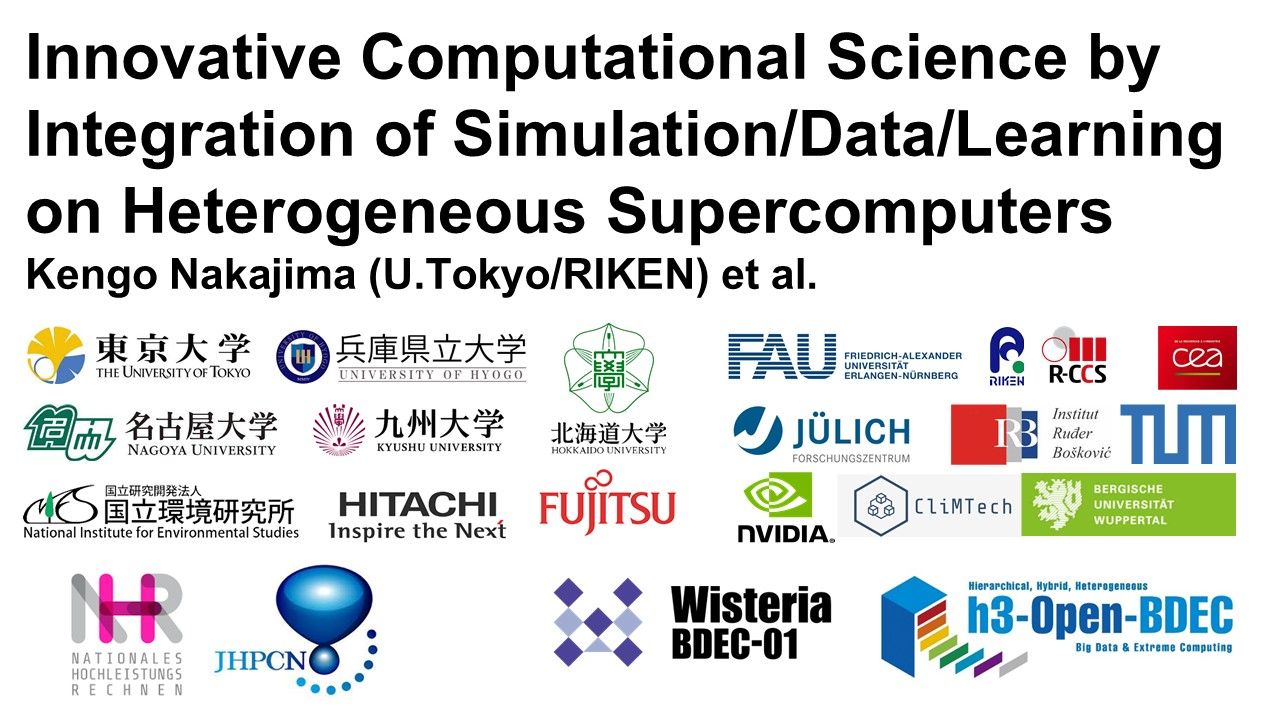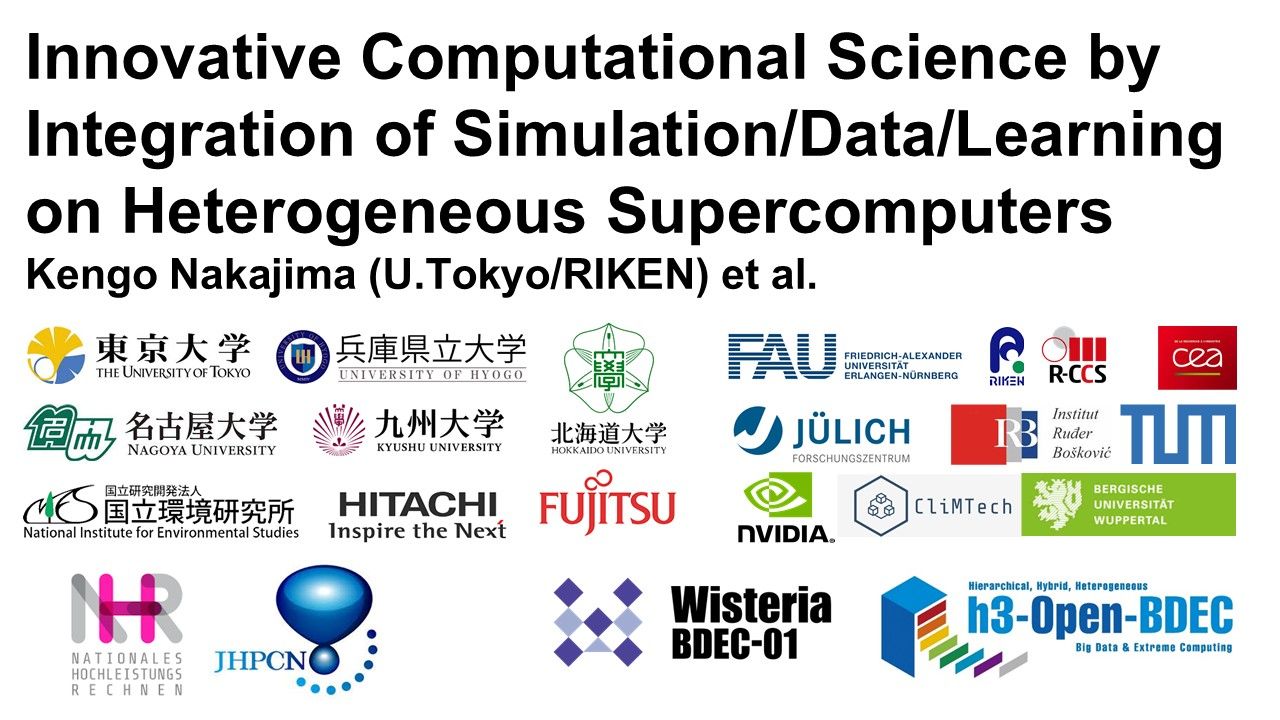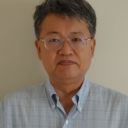

Innovative Computational Science by Integration of Simulation/Data/Learning on Heterogeneous Supercomputers
Tuesday, June 10, 2025 3:00 PM to Thursday, June 12, 2025 4:00 PM · 2 days 1 hr. (Europe/Berlin)
Foyer D-G - 2nd floor
Project Poster
Bioinformatics and Life SciencesComputational PhysicsEarth, Climate and Weather ModelingHeterogeneous System ArchitecturesIntegration of Quantum Computing and HPC
Information
Poster is on display.
The Joint Usage/Research Center for Interdisciplinary Large-scale Information Infrastructures (JHPCN) is a consortium of supercomputer centers of 8 national universities in Japan, and has been supporting interdisciplinary projects since 2010. More than 70 proposals have been adopted each year, and a total of 200M JPY worth of computational resources are provided to these projects. This poster provides an overview of an international JHPCN project, a collaboration between Japan, Germany, France, and Croatia, which started in 2021. In this project, we advance computational science by integrating "Simulation/Data/Learning (S+D+L)” using heterogeneous supercomputers like Wisteria/BDEC-01 at the University Tokyo, Japan and Modular Supercomputing Architecture at JSC (Jülich Supercomputing Centre, Germany). The Wisteria/BDEC-01 system, launched at the University of Tokyo in May 2021, integrates (S+D+L). The Simulation Node Group (Odyssey) features 7,680 Fujitsu/ARM A64FX nodes (Fugaku-Compatible), delivering 25.9 PFLOP/s. The Data/Learning Node Group (Aquarius) has 90 Intel Xeon Ice Lake CPUs and 360 NVIDIA A100 GPUs, offering 7.2 PFLOP/s. Both groups are connected via InfiniBand EDR at 2.0 TB/s, and Aquarius can access external resources through networks like SINET for real-time data acquisition. h3-Open-BDEC is a software infrastructure for integration of (S+D+L) on Wisteria/BDEC-01, which is supported by the Japanese Government (2019-2023). h3-Open-SYS/WaitIO, part of the h3-Open-BDEC, is a system-wide communication library that uses an MPI-like API to combine multiple MPI programs for heterogeneous environments. h3-Open-UTIL/MP, another component of h3-Open-BDEC, is originally a multi-physics coupler. Furthermore, it is equipped with a function for ensemble coupling, and with an interface for coupling codes for large-scale simulations on Odyssey and ML/AI codes written in Python on Aquarius by combining with h3-Open-SYS/WaitIO. In this project, by using h3-Open-BDEC on Wisteria/BDEC-01, we have promoted innovative computational science by integrating (S+D+L) in earth science, life science, and quantum sciences. This poster highlights the following main results of activities, such as (1) 3D seismic wave propagation simulation integrated with real-time data assimilation, (2) Simulation-AI Coupling in Global Cloud Simulation, (3) Ensemble Coupling for Weather/Climate Simulation, (4) Terrestrial Systems Modeling Platform (TSMP) , (5) Big-DFT with GENESIS for SARS-CoV-2 Main Protease (part of HANAMI project), and (6) Quantum-HPC hybrid framework. (2) is one of the typical examples of workloads that integrate (S+D+L). “Global cloud simulation” consists of simulation using a detailed model and “parameterization” using a coarse grid. We coupled simulation by NICAM (Nonhydrostatic ICosahedral Atmospheric Model) on Odyssey and AI/ML (training and inferencing) on Aquarius using h3-Open-UTIL/MP, and attempted to replace parameterization (about 25% of all calculations) with a surrogate model. ML has generally yielded good results, but peak values have not been clearly captured. In addition to introducing new parameters, we are also going to apply technologies of generative AI, such as Vision Transformer, for improvement of the inferencing. h3-Open-UTIL/MP can handle coupling of scientific simulations on Odyssey, and AI/ML workloads on Aquarius. h3-Open-BDEC is widely-used in various types of workloads that integrate (S+D+L) on Wisteria/BDEC-01.
Contributors:
The Joint Usage/Research Center for Interdisciplinary Large-scale Information Infrastructures (JHPCN) is a consortium of supercomputer centers of 8 national universities in Japan, and has been supporting interdisciplinary projects since 2010. More than 70 proposals have been adopted each year, and a total of 200M JPY worth of computational resources are provided to these projects. This poster provides an overview of an international JHPCN project, a collaboration between Japan, Germany, France, and Croatia, which started in 2021. In this project, we advance computational science by integrating "Simulation/Data/Learning (S+D+L)” using heterogeneous supercomputers like Wisteria/BDEC-01 at the University Tokyo, Japan and Modular Supercomputing Architecture at JSC (Jülich Supercomputing Centre, Germany). The Wisteria/BDEC-01 system, launched at the University of Tokyo in May 2021, integrates (S+D+L). The Simulation Node Group (Odyssey) features 7,680 Fujitsu/ARM A64FX nodes (Fugaku-Compatible), delivering 25.9 PFLOP/s. The Data/Learning Node Group (Aquarius) has 90 Intel Xeon Ice Lake CPUs and 360 NVIDIA A100 GPUs, offering 7.2 PFLOP/s. Both groups are connected via InfiniBand EDR at 2.0 TB/s, and Aquarius can access external resources through networks like SINET for real-time data acquisition. h3-Open-BDEC is a software infrastructure for integration of (S+D+L) on Wisteria/BDEC-01, which is supported by the Japanese Government (2019-2023). h3-Open-SYS/WaitIO, part of the h3-Open-BDEC, is a system-wide communication library that uses an MPI-like API to combine multiple MPI programs for heterogeneous environments. h3-Open-UTIL/MP, another component of h3-Open-BDEC, is originally a multi-physics coupler. Furthermore, it is equipped with a function for ensemble coupling, and with an interface for coupling codes for large-scale simulations on Odyssey and ML/AI codes written in Python on Aquarius by combining with h3-Open-SYS/WaitIO. In this project, by using h3-Open-BDEC on Wisteria/BDEC-01, we have promoted innovative computational science by integrating (S+D+L) in earth science, life science, and quantum sciences. This poster highlights the following main results of activities, such as (1) 3D seismic wave propagation simulation integrated with real-time data assimilation, (2) Simulation-AI Coupling in Global Cloud Simulation, (3) Ensemble Coupling for Weather/Climate Simulation, (4) Terrestrial Systems Modeling Platform (TSMP) , (5) Big-DFT with GENESIS for SARS-CoV-2 Main Protease (part of HANAMI project), and (6) Quantum-HPC hybrid framework. (2) is one of the typical examples of workloads that integrate (S+D+L). “Global cloud simulation” consists of simulation using a detailed model and “parameterization” using a coarse grid. We coupled simulation by NICAM (Nonhydrostatic ICosahedral Atmospheric Model) on Odyssey and AI/ML (training and inferencing) on Aquarius using h3-Open-UTIL/MP, and attempted to replace parameterization (about 25% of all calculations) with a surrogate model. ML has generally yielded good results, but peak values have not been clearly captured. In addition to introducing new parameters, we are also going to apply technologies of generative AI, such as Vision Transformer, for improvement of the inferencing. h3-Open-UTIL/MP can handle coupling of scientific simulations on Odyssey, and AI/ML workloads on Aquarius. h3-Open-BDEC is widely-used in various types of workloads that integrate (S+D+L) on Wisteria/BDEC-01.
Contributors:
Format
On DemandOn Site

